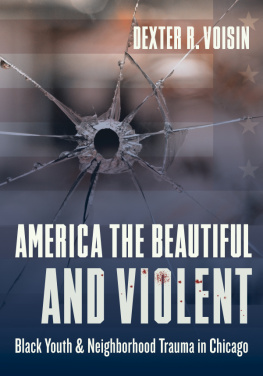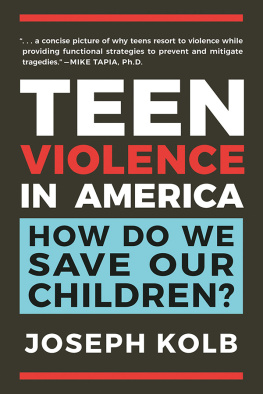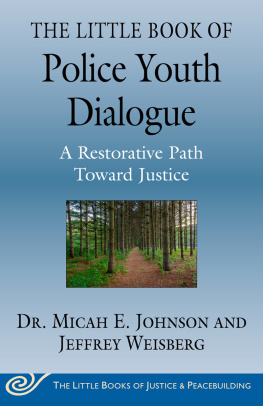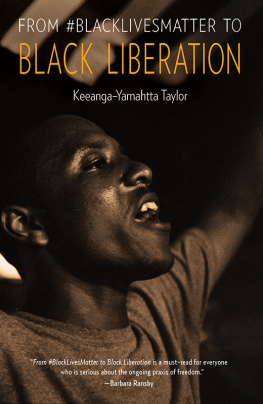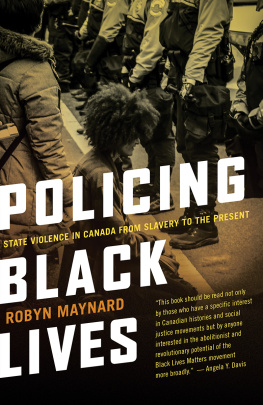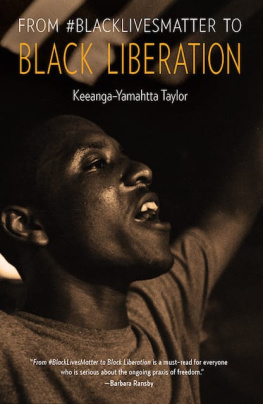Columbia University Press
Publishers Since 1893
New York Chichester, West Sussex
cup.columbia.edu
Copyright 2019 Columbia University Press
All rights reserved
E-ISBN 978-0-231-54547-1
Library of Congress Cataloging-in-Publication Data
Names: Voisin, Dexter R., author.
Title: America the beautiful and violent: black youth and neighborhood trauma in Chicago / Dexter R. Voisin.
Description: New York: Columbia University Press, [2019] | Includes index.
Identifiers: LCCN 2018058447 (print) | LCCN 2019015684 (e-book) | ISBN 9780231545471 (electronic) | ISBN 9780231184403 (cloth: alk. paper) | ISBN 9780231184410 (pbk.)
Subjects: LCSH: Youth and violenceIllinoisChicago. | African American youthIllinoisChicago. | Urban poorIllinoisChicago.
Classification: LCC HQ799.2.V56 (e-book) | LCC HQ799.2.V56 V65 2019 (print) | DDC 303.6083509773/11dc23
LC record available at https://lccn.loc.gov/2018058447
A Columbia University Press E-book.
CUP would be pleased to hear about your reading experience with this e-book at .
Cover design: Lisa Hamm
Cover image: Digital composite
Until lions write their own history, the tale of the hunt will always glorify the hunter.
AFRICAN PROVERB
I never intended to write a book, just as I never intended to become an academic. As a clinical social worker in the early 1990s, I worked mostly in cities, counseling clients struggling with mental illness and substance abuse. Their stories were profound, sometimes tragic, with many moments of courage, compassion, sacrifice, and prideall deeply affecting tales about the resiliency of the human spirit. One in particular changed the path of my lifes work.
In Atlanta during the winter of 1994, I was assigned a new client, a twenty-three-year-old black man, whom I will call Tim, who was just a few years younger than I. He had a slight frame, a warm complexion, and eyes that were bright and alert. His intake form noted a diagnosis of major depression and substance use, with a history of sexual abuse and trauma starting at age ten. He was now hospitalized with AIDS. In 1992, at the height of the epidemic, HIV-infected people had to take first-generation drugs, often as many as thirty pills per day. They were forced to hide their diagnosis to avoid being fired by their employers, ostracized by entire communities, or even killed. An AIDS diagnosis was often associated with increased mortality, especially for those who avoided treatment out of fear or who were in denial about their diagnosis. The time from receiving an AIDS diagnosis to rapid physical decline was often devastatingly swift.
While I was with Tim, we discussed the lack of support he received from his family owing to his diagnosis and the fact that he was gay. The following week, when I returned for my second session with Tim, the nurses informed me that he had been moved to a private room. I entered the dimly lit room and thought I had mistakenly walked in on the wrong client. Tim was now barely recognizable, a mere shadow of the man I had visited just seven days before. He had lost about fifteen pounds from his already tiny frame, his body swallowed up by the white bed sheets. His face was gaunt, his eyes protruding and his complexion darkened.
It was the first time I had encountered a hospitalized person facing death from AIDS. I was not afraid of Tims diagnosis but was startled by the presence of death, which seemed to cast a shadow around his bed. I had experienced death up close only once before, and I was taken aback by its brazen claim on someone so young. He was afraid, and I was afraid for him. I dont want to die alone, he said. I sat next to him and held his hand. This violated my training not to touch clients, but in that moment, I followed my instinct to reassure and comfort him. The following week, when I returned for our third session, Tim had passed away. I made several calls to his mother, but my messages were never returned. The county buried his remains.
Although Tim was my first client hospitalized with AIDS, over the years I came to understand what might lie behind his story and those of others. I heard hundreds of horrendous stories told by clients who, as children, had been physically abused, sexually violated, or both. Many began using alcohol and other drugs to treat their deep emotional pain. For some of them, self-medicating with drugs and/or having unsafe sex resulted in their contracting HIV. After hearing many such stories, I recognized the repeated connections among personal trauma, substance use, and HIV acquisition. As my clinical and intellectual curiosity about these connections grew, I decided to enroll in a doctoral program at Columbia University to study them in more depth.
Over the course of this new academic journey, I came to realize that the scholarly literature had much to say about the connections among childhood sexual abuse, drug use, and unsafe sexual practices; however, most of this knowledge centered on white females. I stumbled across statistics documenting that urban youth, especially blacks and males, experienced homicide rates that were up to eight times higher than those of their white and Latino peers. I began wondering whether witnessing neighborhood violence might be related to the higher reported rates of drug use and risky sexual behaviors. This became my dissertation topic.
I planned to return to Atlanta after graduation to pursue counseling focused on trauma and mental health. However, several distinguished universities came knocking, and I was offered six tenure-track positions. I accepted a job offer from the University of Chicago, packed up my life, and moved, thinking that I would try academia for one year.
Now, after twenty years in the academy, I am still researching the psychological and behavioral effects of exposure to neighborhood violence and how youth and families cope with such trauma. Most of my work has focused on black youth living in U.S. cities. I have published more than 125 peer-reviewed articles on exposure to neighborhood violence and related topics, but I never intended to write a book.
However, after years of work through which I came to be considered an expert on the topic of neighborhood violence, I have grown increasingly tired of giving countless interviews on gun violence, mass murder, and senseless killings taking place in Chicago and elsewhere. While many conversations with reporters last more than an hour, the final print or television interviews are whittled down to two-minute clips to fit an American news format characterized by sound bites. I am frustrated that the complexities driving such uneven exposure to violence and its developmental consequences are diluted in this way.
These stories often refer to the plight of black youth, especially males, with their high unemployment, poor high school graduation rates, rap sheets by age eighteen, gang involvement, teen parenthood, and so forth. These accounts, while pointing to real disparities, are grievously incomplete and often stigmatizing, especially because they are not scripted by these youth, their families, or their communities. Nor do these stories explicate the structural factors and uneven policies that uphold and fuel these disparities, although black public intellectuals, activists, and thought leaders have long attempted to broaden public awareness of these issues. Violent neighborhood enclaves grew out of decades of societal disinvestment, structural and economic violence, and inequality in U.S. social policyincluding systematic residential segregation on explicitly racial grounds. Furthermore, many of these news stories do not tell the many narratives of resiliency and fortitude: stories of personal triumph, family support, neighborhood activism, and social movements, such as the globally influential Movement for Black Lives (also known by the popular slogan Black Lives Matter).

